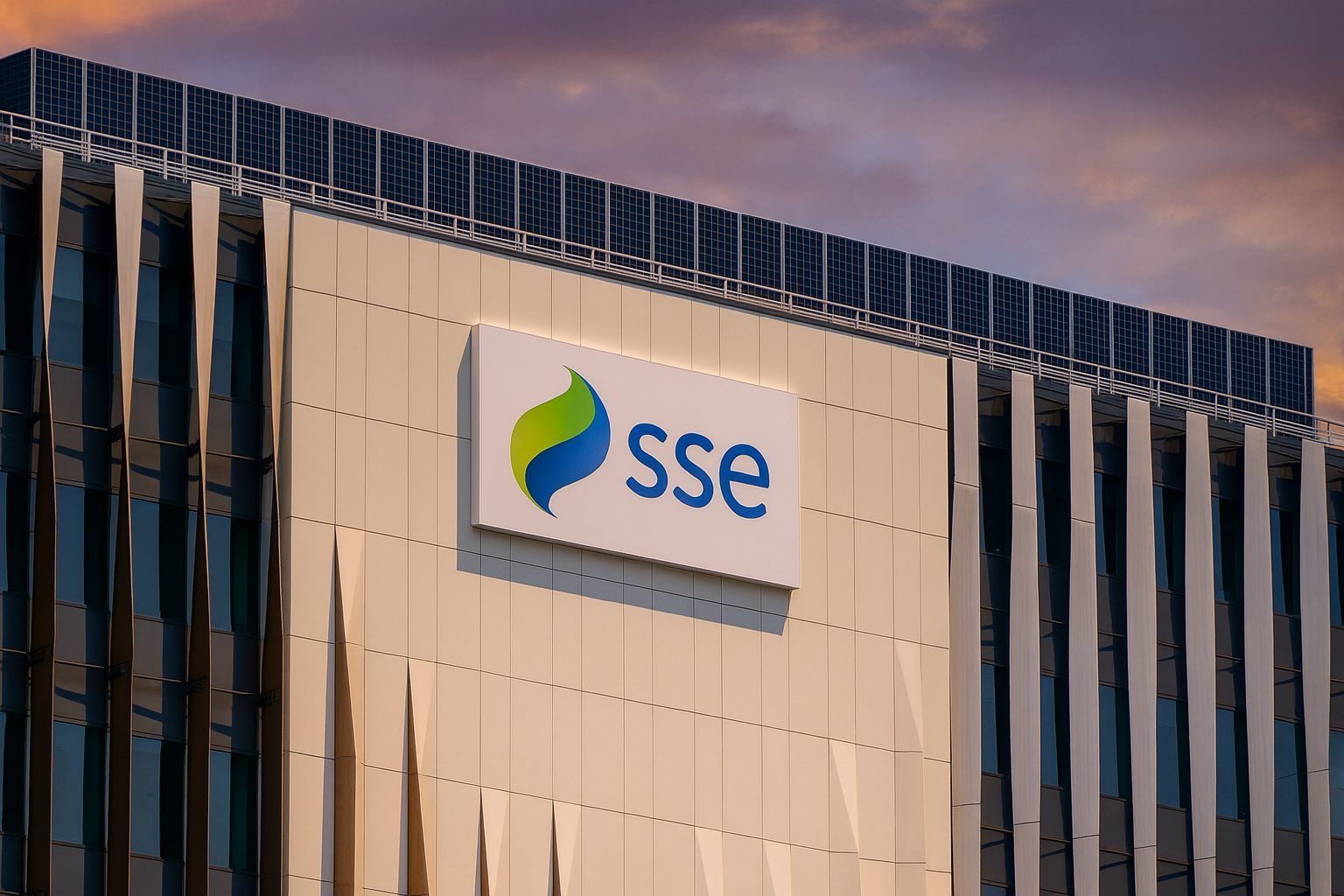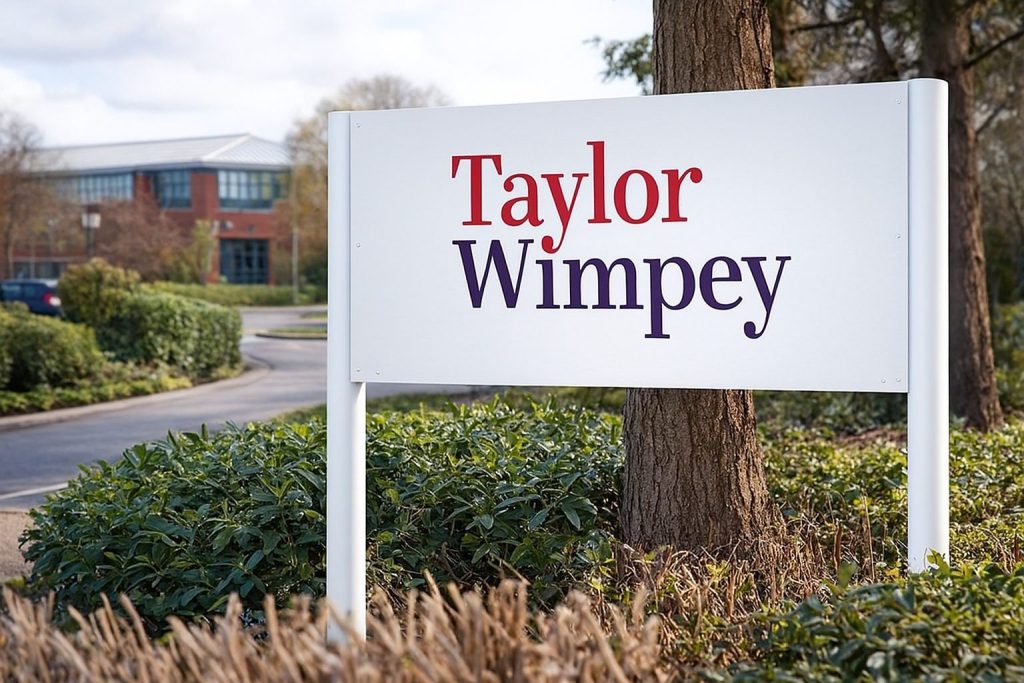SSE plc (LON:SSE) remains firmly in the spotlight on Wednesday, 26 November 2025, as its share price hovers near recent highs and another heavyweight broker – Goldman Sachs – raises its target price following this month’s huge £33bn “Transformation for Growth” investment plan.
While there is no fresh regulatory news from the company itself today, new analyst upgrades and ongoing reaction to the five‑year investment strategy are shaping market sentiment around the FTSE 100 utility.
Key points
- Share price today: SSE is trading around £21.6–£21.9 per share, roughly flat to slightly lower on the day but up about 34% year‑to‑date. [1]
- New broker move:Goldman Sachs has lifted its target price to 2,535p (from 2,299p) and reiterated a ‘buy’ rating, implying mid‑teens upside from current levels. [2]
- Strategic backdrop: Earlier this month SSE unveiled a fully funded £33bn, five‑year investment plan focused mainly on UK electricity networks, backed by a £2bn equity placing.
- Earnings update: Half‑year results showed adjusted operating profit down 24% and EPS down 29%, but in line with expectations and accompanied by a 21.4p interim dividend.
- Balance sheet support:S&P affirmed SSE’s BBB+ credit rating with a stable outlook after reviewing the new investment plan and funding mix. [3]
- Project momentum: Planning consent for the Lewis Hub and progress on projects such as the Orkney Link and Dogger Bank underline how quickly the networks‑heavy strategy is moving. [4]
SSE share price today, 26 November 2025
By late morning in London, SSE shares were changing hands at roughly 2,180–2,190p, down a fraction on the day after opening a little lower. [5]
MarketScreener’s real‑time estimate shows the stock at 2,160.5p, up 0.44% in early trade and about 34% higher year‑to‑date, highlighting just how strong the run‑up has been in 2025. [6] Data from broker Davy puts the midday price slightly higher at 2,186p, with the day’s range so far between 2,165p and 2,189p on volume of nearly 2.5 million shares. [7]
The move today is modest compared with the fireworks earlier this month, when SSE soared more than 10% in a single session after revealing its five‑year plan and funding details, briefly topping the FTSE 100 risers board. [8] Since then the share price has been consolidating at elevated levels as investors digest the scale of the investment and the new equity issue.
Goldman Sachs raises SSE price target to 2,535p
The main SSE‑specific headline on 26 November 2025 comes from the broker community. In a round‑up of London broker moves published this morning, Alliance News reports that Goldman Sachs has raised its price target on SSE from 2,299p to 2,535p while reiterating a “buy” rating. [9]
With the shares trading a little above £21, the new target implies mid‑teens percentage upside from current levels. The upgrade appears in a broader “London broker ratings” note that also includes calls on Shell, Genus, Beazley and others, but the SSE move is a clear signal that at least one major investment bank believes there is still room for further gains after this month’s rally. [10]
Goldman’s call adds to a cluster of positive research published since SSE laid out its Transformation for Growth strategy. On 20 November, for example, Barclays raised its SSE price target, citing improved “business and financial clarity” following the strategic update. [11] A few days earlier, RBC described SSE as “primed and ready” for growth on the new plan, estimating a five‑year EPS compound annual growth rate close to 7.9% to fiscal 2030 – right in the middle of management’s 7–9% target range.
Inside SSE’s £33bn “Transformation for Growth” plan
At the heart of the SSE investment story – and of today’s broker optimism – is the company’s £33bn fully funded five‑year plan extending to the 2029/30 financial year.
According to SSE’s strategic update:
- The plan represents a trebling of investment compared with the current five‑year period.
- Roughly 80% (about £27bn) will go into regulated UK electricity networks, with the remaining ~£6bn directed to renewables and flexible generation.
- The company expects its regulated asset value (RAV) to grow at about 25% a year, more than tripling by 2029/30.
- Management is targeting adjusted EPS of 225–250p in 2029/30, implying a 7–9% compound annual growth rate from a 2024/25 baseline.
Where the £33bn is going
SSE’s slide deck breaks the programme down as follows:
- SSEN Transmission (~£22bn, ~67% of the plan)
Focused on delivering the RIIO‑T3 investment programme, including Pathway to 2030 projects that will connect huge volumes of new offshore wind and other renewables to the GB grid. - SSEN Distribution (~£5bn, ~15%)
Upgrading electricity distribution networks in the north of Scotland and central southern England to handle electrification of heating and transport and growing demand from data centres and industry. - SSE Renewables (~£4bn, ~12%)
Funding the existing construction pipeline and new options, taking SSE’s installed renewables capacity to a targeted ~9GW by 2029/30. - SSE Thermal and other businesses (~£2bn, ~6%)
Primarily flexible generation and related infrastructure supporting system reliability as more intermittent renewables come online.
SSE emphasises that by 2029/30 around 80% of Group EBITDA will be index‑linked, backed largely by regulated network revenues, which should make cash flows more predictable.
Funding the plan
To deliver the £33bn plus around £6bn of dividends, tax and other cash flows, SSE has outlined a funding mix it describes as “fully funded”:
- ~55% (about £21bn) from operational cash generation
- ~35% (about £14bn) from higher net debt and hybrid capital, with the aim of keeping net debt/EBITDA below 4.5x throughout the plan
- ~5% (about £2bn) via a concurrent equity placing, launched on 12 November
- ~5% (about £2bn) from asset rotation, selling selected stakes to recycle capital
SSE argues this combination allows it to invest heavily while maintaining strong investment‑grade credit ratings, a point reinforced by S&P’s subsequent decision to affirm its BBB+ / A‑2 rating with a stable outlook. [12]
The company also plans to keep growing its dividend with a 5–10% annual increase in dividend per share out to 2029/30, from a 2024/25 baseline. Consensus estimates compiled by MarketScreener imply a forward yield a little above 3% on the current share price for the 2026–27 financial years. [13]
Half‑year results: profits dip but networks take centre stage
Alongside the strategy update, SSE reported results for the six months to 30 September 2025. The figures show a transition year as profits shift further towards regulated networks and away from more volatile activities.
Key numbers from the interim statement:
- Adjusted operating profit: £655m (down from £860m a year earlier, a 24% decline)
- Adjusted earnings per share:36.1p vs 50.7p, a 29% drop
- Adjusted net finance costs: broadly flat despite higher debt, thanks to more capitalised interest on large projects
- Capex:£1.6bn in the half, around two‑thirds in networks, reflecting the ramp‑up in transmission spend
By division, SSEN Transmission’s adjusted operating profit almost doubled to £292.1m, reflecting increased allowed revenue on major projects, while SSEN Distribution’s profit fell sharply to £127.9m due to the absence of a prior‑year inflation catch‑up in revenues. Renewables earnings were lower at £275.6m, hurt by less favourable weather and lower hedged power prices, while thermal and gas storage losses narrowed.
Networks’ regulated asset value has already grown around 20% year‑on‑year to £14.2bn, and SSE reaffirmed its divisional profit guidance for both 2025/26 and 2026/27, signalling confidence that the weaker first‑half will be offset later in the year.
The board declared an interim dividend of 21.4p per share, described as one‑third of the planned 2024/25 full‑year payout. A dividend calendar from broker ADSS indicates SSE’s interim is scheduled to go ex‑dividend on 4 December 2025, a date income investors will be watching closely. [14]
Networks and projects: Lewis Hub, Orkney link and Dogger Bank
One reason brokers are comfortable with SSE’s huge capex bill is that regulators and policymakers are signalling strong support for major grid upgrades.
Lewis Hub approval
On 19 November 2025, SSE’s transmission arm announced that planning consent has been granted for the Lewis Hub – a new converter station and substation near Stornoway that will finally connect the Western Isles to the GB transmission network. [15]
The project is part of the Western Isles HVDC Connection, enabling around 1.8GW of new renewable generation to feed into the national grid. It forms a key piece of SSEN Transmission’s plan to invest at least £22bn by March 2031, potentially rising to £31.7bn, which independent analysis suggests could support up to 17,500 jobs in Scotland and add around £7bn to the Scottish economy. [16]
Lewis Hub comes with a suite of local benefits, including funding for nearly 100 new homes near Stornoway, road upgrades and support for community organisation Macaulay College, alongside more than £100m of community benefit funding expected across the north of Scotland from the broader investment programme. [17]
Orkney link and social value initiatives
Just this week, SSE has also been highlighting progress on other transmission schemes. On 25 November, SSEN Transmission: [18]
- Celebrated one year of delivery on its flagship Orkney link project, which connects the islands to the high‑voltage GB transmission network.
- Became the first business to sign the Highland Social Value Charter, committing to long‑term socio‑economic benefits in the region.
- Welcomed a new Balfour Beatty depot in Kirriemuir, opened to support SSEN projects and expected to support up to 70 local jobs.
These updates reinforce the message that SSE’s network investment plan is not just about financial returns but also about regional development and community engagement.
Dogger Bank’s wider economic impact
On the generation side, SSE Renewables emphasised earlier in November that the Dogger Bank Wind Farm, which it is developing with partners, is expected to deliver around £6.1bn of economic benefit to the UK over its lifetime and support thousands of jobs. [19] Dogger Bank will be the world’s largest offshore wind farm once fully operational, underlining how central SSE has become to Britain’s clean‑energy build‑out.
Credit rating and balance sheet
With such aggressive spending plans, the health of SSE’s balance sheet is crucial. On 13 November, S&P Global Ratings affirmed SSE’s long‑term rating at BBB+ with a stable outlook, explicitly taking into account the expanded capital investment plan and the accompanying funding strategy. [20]
SSE’s own materials show that under its base‑case projections the group expects only about a 35% increase in adjusted net debt and hybrid capital over the period, with net debt/EBITDA kept below 4.5x, leaving it within the thresholds typically required for a strong investment‑grade profile.
That endorsement from S&P came just a day after the company announced its £33bn programme, suggesting the rating agency is comfortable that the plan remains compatible with SSE’s existing credit metrics.
Analyst views: bulls, bears and everything in between
While today’s Goldman Sachs upgrade sits firmly in the bullish camp, analyst opinion on SSE is not entirely one‑sided.
- RBC: In a note titled “SSE ‘Primed and Ready’ for Growth on New Five‑year Strategic Plan”, RBC highlighted an estimated 7.9% EPS CAGR to FY2030, closely matching SSE’s own 7–9% target range, and argued the utility is well placed to benefit from the UK’s power‑grid build‑out.
- Barclays: On 20 November, Barclays raised its SSE price target, citing greater business and financial clarity after the strategic update and supporting a positive outlook on the stock. [21]
- Citi: In contrast, Citi downgraded SSE to “sell” on 14 November, even as it acknowledged that the equity issue and long‑term EPS guidance improved visibility. The bank pointed out that SSE’s share price had re‑rated sharply – nearly 40% in two months and 17% in a single day – and trimmed its target price to 1,997p.
Against that backdrop, today’s Goldman Sachs move to a 2,535p target keeps the stock firmly in the “buy” column for another global bank and effectively re‑anchors the upper end of the analyst target‑price range after the recent rally. [22]
What could move SSE’s share price next?
With the strategic plan now out in the open and the equity placing underway, investors will be focused on several upcoming catalysts:
- Dividend timetable
The interim dividend’s 4 December ex‑dividend date and subsequent payment could attract income‑focused buyers or prompt some short‑term profit‑taking around that time. [23] - Execution of the £33bn plan
Markets will watch closely for further project approvals (especially in transmission), contract awards and construction milestones – particularly for Pathway to 2030 projects, Western Isles links and Dogger Bank phases. - Regulation and interest rates
As a capital‑intensive regulated utility, SSE’s valuation is sensitive to Ofgem decisions, UK interest‑rate expectations and inflation, all of which affect allowed returns and discount rates on long‑dated cash flows. - Further analyst revisions
Today’s Goldman Sachs upgrade follows a flurry of post‑strategy research. Additional target‑price changes or rating shifts – in either direction – could influence the share price, especially given the stock’s strong recent performance.
Bottom line
For 26 November 2025, the key SSE development is Goldman Sachs’ decision to lift its target price to 2,535p and reiterate a “buy” recommendation, signalling that big‑name analysts still see upside even after a powerful rally. [24]
Underneath the day‑to‑day share‑price moves, the story remains the same: SSE is betting heavily on regulated electricity networks and large‑scale renewables, backed by a £33bn, fully funded capex plan, an affirmed BBB+ credit rating, and a dividend policy that still targets mid‑single to high‑single‑digit growth.
Whether that combination justifies today’s valuation is ultimately a judgement call for each investor. As always, this article is for information only and does not constitute investment advice. If you’re considering an investment in SSE plc, it’s worth reviewing the company’s official reports in full and, where appropriate, seeking independent financial advice.
References
1. www.marketscreener.com, 2. www.sharesmagazine.co.uk, 3. www.spglobal.com, 4. www.sse.com, 5. www.davy.ie, 6. www.marketscreener.com, 7. www.davy.ie, 8. uk.finance.yahoo.com, 9. www.sharesmagazine.co.uk, 10. www.sharesmagazine.co.uk, 11. www.marketscreener.com, 12. www.spglobal.com, 13. www.marketscreener.com, 14. www.adss.com, 15. www.sse.com, 16. www.sse.com, 17. www.sse.com, 18. www.sse.com, 19. www.sse.com, 20. www.spglobal.com, 21. www.marketscreener.com, 22. www.sharesmagazine.co.uk, 23. www.adss.com, 24. www.sharesmagazine.co.uk







